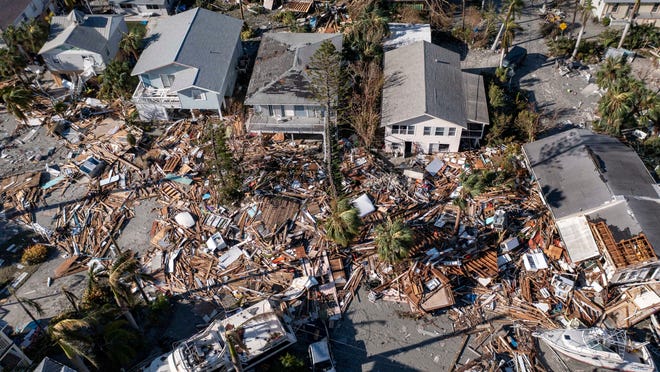- Ian is forecast to wallop much of the southeastern U.S. with a nasty mix of rain, wind and storm surge over the next few days.
- Hurricane and storm surge warnings have been issued for the South Carolina coast.
- States of emergencies have been issued in Georgia, Virginia and the Carolinas.
After blasting Florida Wednesday and Thursday, Ian isn’t done yet.
In fact, the hurricane, which had been downgraded to a tropical storm as it spun over the western Atlantic Ocean, is forecast to wallop much of the southeastern U.S. with a nasty mix of rain, wind and storm surge over the next few days, forecasters said. It once again regained hurricane strength Thursday evening with 75 mph winds.
Ian is forecast to make another landfall in South Carolina during the day on Friday, the National Hurricane Center said Thursday afternoon.
Where are hurricane and storm surge warnings?
Hurricane and storm surge warnings have been issued for the South Carolina coast because of Ian’s predicted approach, the Hurricane Center said.
As of Thursday, the center of Ian had emerged into the western Atlantic and it became a hurricane again. It’s forecast to make landfall as a hurricane on Friday.
IAN UPDATES:Tropical Storm Ian still pounding Florida; first deaths reported; 2.6M without power: Live updates
Even after weakening some on Thursday, Ian’s tropical-storm force winds still reached 415 miles from its center on Thursday afternoon, the Hurricane Center said.
The Hurricane Center warned that storm surge of 6 feet or more was still possible from Daytona Beach, Florida, to north of Charleston, South Carolina. And rainfall of up to 8 inches threatened flooding in the Carolinas and Virginia.
“It doesn’t matter what the intensity of the storm is. We’re still expecting quite a bit of rainfall,” Robbie Berg, senior hurricane specialist with the Hurricane Center, said.
How much of the Southeast is at risk?
States of emergencies have been issued in Georgia, Virginia and the Carolinas as meteorologists warn that Ian’s dangers will continue across the Southeast, and hazards both inland and along the coast are expected, according to AccuWeather.
“Tropical rainfall is forecast to impact more than half a dozen states into this weekend,” AccuWeather senior meteorologist Courtney Travis said.
Up to a foot of rain was forecast for parts of northeast Florida, coastal Georgia and Virginia over the next couple of days, AccuWeather said.
IAN TRACKER:Charting the path of where tropical storm is headed next
What will be the impact on Georgia and Virginia?
As much as 6 inches could fall in southern Virginia as the storm moves inland over the Carolinas, and the National Hurricane Center said landslides were possible in the southern Appalachian mountains.
A large swath from Georgia to Virginia is forecast to pick up at least 2-4 inches of rain from Ian spanning Friday through the weekend, according to Accuweather. A persistent stream of moisture off the warm Gulf Stream waters of the Atlantic Ocean will fuel even higher rainfall totals of 12-18 inches for coastal areas of Georgia and part of South Carolina.
What will be the impact on South Carolina?
A hurricane warning was issued Thursday for the entire coast of South Carolina as storm Ian’s center drifted off the coast of Florida and back out to sea.
The National Weather Service’s latest forecast showed that Ian’s winds were at 70 mph, just shy of hurricane force. The warm Atlantic waters are expected to help it gather strength as it curves back toward the U.S. coast.
In Charleston, South Carolina, officials opened parking garages so residents could get their cars above the imminent flooding.
WEIRD WEATHER:Why did water leave Tampa Bay during Hurricane Ian? What to know about reverse storm surge
Forecasters predicted the seventh-highest water level Friday afternoon in Charleston in more than 120 years of records, at 8.7 feet above the average low tide at the downtown harbor.
South Carolina Gov. Henry McMaster joined his counterparts in Georgia and North Carolina in declaring a state of emergency so officials could access resources and receive federal emergency money.
Schools planned to go to online learning to keep buses off the road.
Contributing: The Associated Press


